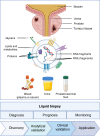Extracellular vesicles as a source of prostate cancer biomarkers in liquid biopsies: a decade of research
- PMID: 34811504
- PMCID: PMC8810769
- DOI: 10.1038/s41416-021-01610-8
Extracellular vesicles as a source of prostate cancer biomarkers in liquid biopsies: a decade of research
Abstract
Prostate cancer is a global cancer burden and considerable effort has been made through the years to identify biomarkers for the disease. Approximately a decade ago, the potential of analysing extracellular vesicles in liquid biopsies started to be envisaged. This was the beginning of a new exciting area of research investigating the rich molecular treasure found in extracellular vesicles to identify biomarkers for a variety of diseases. Vesicles released from prostate cancer cells and cells of the tumour microenvironment carry molecular information about the disease that can be analysed in several biological fluids. Numerous studies document the interest of researchers in this field of research. However, methodological issues such as the isolation of vesicles have been challenging. Remarkably, novel technologies, including those based on nanotechnology, show promise for the further development and clinical use of extracellular vesicles as liquid biomarkers. Development of biomarkers is a long and complicated process, and there are still not many biomarkers based on extracellular vesicles in clinical use. However, the knowledge acquired during the last decade constitutes a solid basis for the future development of liquid biopsy tests for prostate cancer. These are urgently needed to bring prostate cancer treatment to the next level in precision medicine.
© 2021. The Author(s).
Conflict of interest statement
The authors declare no competing interests.
Figures
Similar articles
-
Utilising extracellular vesicles for early cancer diagnostics: benefits, challenges and recommendations for the future.Br J Cancer. 2022 Feb;126(3):323-330. doi: 10.1038/s41416-021-01668-4. Epub 2022 Jan 10. Br J Cancer. 2022. PMID: 35013578 Free PMC article. Review.
-
Prostate cancer and liquid biopsies: Clinical applications and challenges.Int J Urol. 2024 Jun;31(6):617-626. doi: 10.1111/iju.15441. Epub 2024 Mar 29. Int J Urol. 2024. PMID: 38551314 Review.
-
Cell-free DNA technologies for the analysis of brain cancer.Br J Cancer. 2022 Feb;126(3):371-378. doi: 10.1038/s41416-021-01594-5. Epub 2021 Nov 22. Br J Cancer. 2022. PMID: 34811503 Free PMC article. Review.
-
Extracellular vesicle-derived biomarkers in prostate cancer care: Opportunities and challenges.Cancer Lett. 2024 Oct 1;601:217184. doi: 10.1016/j.canlet.2024.217184. Epub 2024 Aug 12. Cancer Lett. 2024. PMID: 39142499 Review.
-
Extracellular vesicles: the next generation of biomarkers for liquid biopsy-based prostate cancer diagnosis.Theranostics. 2020 Jan 16;10(5):2309-2326. doi: 10.7150/thno.39486. eCollection 2020. Theranostics. 2020. PMID: 32089744 Free PMC article. Review.
Cited by
-
Hydrogen Peroxide Promotes the Production of Radiation-Derived EVs Containing Mitochondrial Proteins.Antioxidants (Basel). 2022 Oct 27;11(11):2119. doi: 10.3390/antiox11112119. Antioxidants (Basel). 2022. PMID: 36358489 Free PMC article.
-
Small extracellular vesicles: crucial mediators for prostate cancer.J Nanobiotechnology. 2025 Mar 21;23(1):230. doi: 10.1186/s12951-025-03326-w. J Nanobiotechnology. 2025. PMID: 40114183 Free PMC article. Review.
-
Validation of potential RNA biomarkers for prostate cancer diagnosis and monitoring in plasma and urinary extracellular vesicles.Front Mol Biosci. 2023 Nov 30;10:1279854. doi: 10.3389/fmolb.2023.1279854. eCollection 2023. Front Mol Biosci. 2023. PMID: 38099195 Free PMC article.
-
Circulating Tumor DNA Biomarkers for Response Assessment in Prostate Cancer.Clin Cancer Res. 2023 Aug 1;29(15):2745-2747. doi: 10.1158/1078-0432.CCR-23-1043. Clin Cancer Res. 2023. PMID: 37265409 Free PMC article.
-
Extracellular Vesicles Isolation from Large Volume Samples Using a Polydimethylsiloxane-Free Microfluidic Device.Int J Mol Sci. 2023 Apr 27;24(9):7971. doi: 10.3390/ijms24097971. Int J Mol Sci. 2023. PMID: 37175677 Free PMC article.
References
-
- Sung H, Ferlay J, Siegel RL, Laversanne M, Soerjomataram I, Jemal A, et al. Global cancer statistics 2020: GLOBOCAN estimates of incidence and mortality worldwide for 36 cancers in 185 countries. CA Cancer J Clin. 2021;71:209–49. - PubMed
-
- Egevad L, Delahunt B, Srigley JR, Samaratunga H. International society of urological pathology (ISUP) grading of prostate cancer—An ISUP consensus on contemporary grading. APMIS. 2016;124:433–5. - PubMed
-
- D’Amico AV, Whittington R, Malkowicz SB, Cote K, Loffredo M, Schultz D, et al. Biochemical outcome after radical prostatectomy or external beam radiation therapy for patients with clinically localized prostate carcinoma in the prostate specific antigen era. Cancer. 2002;95:281–6. - PubMed
Publication types
MeSH terms
Substances
LinkOut - more resources
Full Text Sources
Medical


